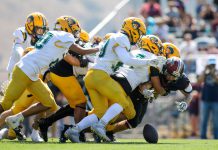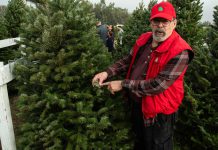Lawson Sakai, a decorated World War Two veteran and Morgan Hill resident, recalled at the Feb. 13 annual meeting of the Friends and Family of Nisei Veterans how German artillery and mortars came crashing through the treetops of the Vosges mountains in France when his unit was in the process of rescuing the “Lost Battalion.”
He said the falling branches and tree trunks in the densely wooded forest endangered him and his compatriots in the 442nd Regimental Combat Team as much as the artillery fire during the 1944 battle. He recalled the wet, muddy conditions on steep, rugged mountains that resulted in low visibility and close combat with the enemy.
“We would slip and slide up the mountain, fall down, and help each other get up,” Sakai said to a crowd of about 100 guests and FFNV members at the Morgan Hill Buddhist Center. “The Germans were shooting down at us, and bullets were flying by your head… The shrapnel would come down with big chunks of trees. Many soldiers were crushed.”
The Feb. 13 event in Morgan Hill featured Sakai and military historians presenting a history of the 442nd, and specifically the unit’s mission to rescue the Lost Battalion from the steep mountainsides in France.
The annual meeting of the FFNV was also an opportunity for Consul-General of Japan Jun Yamada to present Sakai with the prestigious Japan Foreign Ministry Award, an honor that Yamada said was long overdue. Yamada said the citizens of Japan and the U.S. should be proud of the efforts Sakai and others have made in fostering happy relations between the two countries.
The Japan Foreign Ministry Award is presented annually to “individuals and groups with outstanding achievements in the promotion of friendship between Japan and the United States,” according to the Consulate-General’s website. The 2015 recipients of the honor include four residents of northern California, including Sakai.
“His whole story is great inspiration to anyone in Japan,” Yamada said. “We all have to be grateful. He’s aware of his ancestry…and we wish more people in Japan would become aware of this story.”
Sakai was born in Los Angeles in 1923 and graduated from Montebello High School in 1941. He tried to enlist in the Army the day after the bombing of Pearl Harbor Dec. 7, 1941. However, he was rejected as an “enemy alien.” Federal authorities subsequently detained Japanese-Americans on the Pacific coast in internment camps.
In March 1943, the U.S. needed more troops for the war effort, and asked for volunteers to form the segregated 442nd, a unit that consisted only of Japanese-American citizens. Sakai immediately signed up, according to FFNV Vice President Brian Shiroyama’s introduction at the Feb. 13 event.
“As a squad leader in E Company, Mr. Sakai fought in all major campaigns, most notable being the liberation of (the) logistically critical French town of Bruyeres, rescue of the ‘Lost Battalion’ and breaking of the Gothic Line in Italy in 1945,” Shiroyama said. “Mr. Sakai fought to prove his loyalty to this country that initially denied him of military service.”
Sakai was wounded four times during World War Two, including once from gunfire during the rescue of the Lost Battalion. He was decorated with a Bronze Star.
The Lost Battalion was the 141st Infantry, 36th Division of the Texas National Guard. The division’s 1st battalion, consisting of 275 American soldiers, were cut off by German forces Oct. 24, 1944, as they tried to make their way through the rugged mountains. Attempts by the 2nd and 3rd battalions to rescue the 1st failed, and the commander finally ordered the 442nd to follow suit.
Two historians of the Lost Battalion and the subsequent rescue—Tom Graves and Franz Steidl—spoke about the military actions at the Feb. 13 presentation.
“For two days and nights (the 141st) desperately tried to break through, but they were held off,” said Graves, author of “Twice Heroes.” “The 275 soldiers of the Lost Battalion were spread out, surrounded by German troops. They were desperate for medical supplies and ammunition.”
The battalion never considered surrendering or leaving their wounded in an escape attempt, according to Graves. Instead, they hunkered down in the muddy mountainsides, waiting for backup and hoping for an accessible airdrop of friendly supplies.
“The airdrops either got tangled in trees or rolled down the steep hillsides,” he said.
On Oct. 30, the 442nd broke through and rescued the Lost Battalion. Two hundred eleven of the trapped soldiers survived. The Americans suffered about 800 casualties during the rescue.
Sakai was shot by enemy troops before the mission was complete, shortly after the 442nd “took the high ground,” he said.
“I got hit and was taken out. I told the medic to let me die right there,” Sakai said. He woke up on a train headed to an American hospital.
After returning home from the war, Sakai married Mineko Sakai of Gilroy, and owned and operated a travel agency in San Jose.
When he retired, Sakai quickly became one of northern California’s most eloquent and prominent speakers on the subject of Japanese-American history and the Nisei (second generation Japanese-American) veterans’ accomplishments, Shiroyama added. He helped convince the East Bay Regional Park Commision in Oakland to plant a redwood tree in honor of the Nisei veterans in 1992, and later founded the FFNV, of which he currently serves as president.
He also created a popular exhibit on the history of Nisei veterans at the USS Hornet museum in Alameda, Shiroyama continued. He is also a recipient of the Congressional Gold Medal.
In another illustration of Sakai’s contribution to foreign relations, in February 2015 he was one of 10 American veterans awarded with France’s Legion of Honor pin, the country’s highest decoration. Sakai wore his red Legion of Honor pin at the Feb. 13 meeting, where he recognized Legion of Honor Officer Odette M. LePendu who was sitting in the Morgan Hill audience.
LePendu was a member of the French Resistance at the age of 14 during World War Two.
“Because of people like you, we were able to succeed,” Sakai told her.







